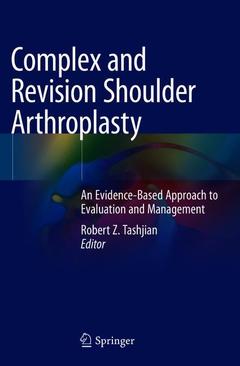Description
Complex and Revision Shoulder Arthroplasty, 1st ed. 2019
An Evidence-Based Approach to Evaluation and Management
Language: English
Subject for Complex and Revision Shoulder Arthroplasty:
271 p. · 17.8x25.4 cm · Hardback
Description
/li>Contents
/li>Biography
/li>Comment
/li>
Utilizing the best clinical evidence, Complex and Revision Shoulder Arthroplasty is an excellent resource for orthopedic and shoulder surgeons, residents and fellows, as well as sports medicine specialists and related professionals.
Part I. Complex Primary Shoulder Arthroplasty: Diagnosis and Management.- Evaluation of Humeral and Glenoid Bone Deformity in Glenohumeral Arthritis.- Computer Assisted Planning and Patient Specific Instrumentation (PSI) in Shoulder Arthroplasty.- Stemless Shoulder Arthroplasty in Treating Severe Deformity.- Severe Glenoid Erosion (B2, B3, C) Treated with Anatomic TSA.- Severe Glenoid Erosion (B2, B3, C, E2, E3) Treated with RSA.- Treatment of Post-traumatic Sequalae with Shoulder Arthroplasty.- Treatment of Deltoid Deficiency and Paralysis in Shoulder Arthroplasty.- Part II. Revision Shoulder Arthroplasty: Diagnosis and Management.- Diagnosis and Management of the Painful Shoulder Arthroplasty.- Management of the Failed Hemiarthroplasty.- Management of the Failed Anatomic Total Shoulder Arthroplasty.- Management of Failed Reverse Total Shoulder Arthroplasty.- Diagnosis and Management of the Infected Shoulder Arthroplasty.- Diagnosis, Management and Prevention of the Unstable Shoulder Arthroplasty.- Treatment of Periprosthetic Fractures of the Shoulder.- Salvage Options for Failed Arthroplasty: Resection and Arthrodesis.- Part III. Revision Shoulder Arthroplasty Techniques.- Surgical Exposure in Revision Shoulder Arthroplasty.- Management of Soft Tissue Problems of the Failed Arthroplasty: Stiffness, Rotator Cuff Tearing and Biceps Pathology.- Management of Large Glenoid Defects: Bone Grafts and Augmented Components.- Management of Large Humeral Defects: Bone Grafts and Augmented Components.- Humeral Windows and Episiotomies.- Arthroscopic Treatment of the Failed Shoulder Arthroplasty.




